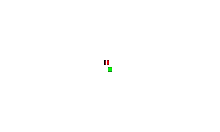Flash lag illusion
The flash lag illusion or flash-lag effect is a visual illusion wherein a flash and a moving object that appear in the same location are perceived to be displaced from one another[1][2]). Several explanations for this simple illusion have been explored in the neuroscience literature (for a review see[3]).


Motion extrapolation
The first proposed explanation for the flash-lag effect is that the visual system is predictive, accounting for neural delays by extrapolating the trajectory of a moving stimulus into the future.[2][4] In other words, when light from a moving object hits the retina, a certain amount of time is required before the object is perceived. In that time, the object has moved to a new location in the world. The motion extrapolation hypothesis asserts that the visual system will take care of such delays by extrapolating the position of moving objects forward in time.
Latency difference
A second proposed explanation is that the visual system processes moving objects more quickly than flashed objects. This latency-difference hypothesis asserts that by the time the flashed object is processed, the moving object has already moved to a new position.[5][6] The latency-difference proposal tacitly rests on the assumption that awareness (what the subject reports) is an on-line phenomenon, coming about as soon as a stimulus reaches its "perceptual end-point".[7]
Motion integration and postdiction
Eagleman & Sejnowski (2000abc) proposed a third alternative:[8][9][10][11][12] visual awareness is neither predictive nor on-line, but is instead postdictive, such that the percept attributed to the time of the flash is a function of events that happen in the ~80 ms following the flash. This postdictive framework is consistent with findings in other fields, such as backward masking in visual psychophysics (Bachmann, 1994), or the color phi phenomenon.[13] In backward masking, a stimulus followed in rapid succession by a second stimulus can block or modify the perception of the first one. In the color phi phenomenon, two colored dots presented sequentially within a small time and distance will appear to have changed color in the middle of their apparent trajectory. Since the viewer cannot know what the color of the second dot will be until having seen the second dot, the only explanation is that the conscious percept attributed to the "trajectory" of the dots is formed after the second dot has "arrived" at its destination. Eagleman & Sejnowski found that the perception attributed to the time of the flash depends on events in the next ~80 ms after the flash.[14] In this way, they drew a correspondence[15] between the flash-lag effect and the Fröhlich effect,[16] wherein the first position of a moving object entering a window is misperceived.
A recent study tries to reconcile these different approaches by approaching perception as an inference mechanism aiming at describing what is happening at the present time.[17] In particular, it could extend the motion extrapolation hypothesis by weighting this prediction by the precision of the current information. Thus, the corrected position of the moving target is calculated by combining the sensory flux with the internal representation of the trajectory, both of which exist in the form of probability distributions. To manipulate the trajectory is to change the precision and therefore the relative weight of these two information when they are optimally combined in order to know where an object is at the present time. For an object that moves predictably, the neural network can infer its most probable position taking into account this processing time. For the flash, however, this prediction can not be established because its appearance is unpredictable. Thus, while the two targets are aligned on the retina at the time of the flash, the position of the moving object is anticipated by the brain to compensate for the processing time: it is this differentiated treatment that causes the flash-lag effect. Moreover, this could also explain related phenomena such as motion reversal.[18]
See also
- Tau effect
- Kappa effect
- Cutaneous rabbit illusion
- Temporal illusions
- Fröhlich effect
References
- MacKay, D. M. (15 February 1958). "Perceptual Stability of a Stroboscopically Lit Visual Field containing Self-Luminous Objects". Nature. 181 (4607): 507–508. doi:10.1038/181507a0. PMID 13517199.
- Nijhawan, Romi (28 July 1994). "Motion extrapolation in catching". Nature. 370 (6487): 256–257. doi:10.1038/370256b0. PMID 8035873.
- Kanai, Ryota; Sheth, Bhavin R; Shimojo, Shinsuke (October 2004). "Stopping the motion and sleuthing the flash-lag effect: spatial uncertainty is the key to perceptual mislocalization". Vision Research. 44 (22): 2605–2619. doi:10.1016/j.visres.2003.10.028. PMID 15358076.
- Khurana, Beena; Nijhawan, Romi (7 December 1995). "Extrapolation or attention shift?". Nature. 378 (6557): 566. doi:10.1038/378566a0.
- Whitney, David; Murakami, Ikuya (1 December 1998). "Latency difference, not spatial extrapolation". Nature Neuroscience. 1 (8): 656–657. doi:10.1038/3659. PMID 10196580.
- Purushothaman, Gopathy; Patel, Saumil S.; Bedell, Harold E.; Ogmen, Haluk (3 December 1998). "Moving ahead through differential visual latency". Nature. 396 (6710): 424. doi:10.1038/24766. PMID 9853748.
- Zeki, S; Bartels, A (22 August 1998). "The asynchrony of consciousness". Proceedings: Biological Sciences. 265 (1405): 1583–5. doi:10.1098/rspb.1998.0475. PMC 1689325. PMID 9744110.
- Eagleman, D. M. (17 March 2000). "Motion Integration and Postdiction in Visual Awareness" (PDF). Science. 287 (5460): 2036–2038. doi:10.1126/science.287.5460.2036. PMID 10720334. Archived from the original (PDF) on 30 September 2007. Retrieved 18 June 2007.
- Patel, S. S. (10 November 2000). "Flash-Lag Effect: Differential Latency, Not Postdiction". Science. 290 (5494): 1051a–1051. doi:10.1126/science.290.5494.1051a. PMID 11184992.
- Krekelberg, Bart; Lappe, Markus (August 1999). "Temporal recruitment along the trajectory of moving objects and the perception of position". Vision Research. 39 (16): 2669–2679. doi:10.1016/S0042-6989(98)00287-9. PMID 10492829.
- Krekelberg, B. (18 August 2000). "The Position of Moving Objects". Science. 289 (5482): 1107a–1107. doi:10.1126/science.289.5482.1107a. PMID 17833394. S2CID 2228258.
- Eagleman, D (1 June 2002). "Untangling spatial from temporal illusions". Trends in Neurosciences. 25 (6): 293. doi:10.1016/S0166-2236(02)02179-3. PMID 12086745.
- Kolers, Paul A.; von Grünau, Michael (January 1976). "Shape and color in apparent motion". Vision Research. 16 (4): 329–335. doi:10.1016/0042-6989(76)90192-9. PMID 941407.
- Eagleman, David M. (December 2001). "Visual illusions and neurobiology" (PDF). Nature Reviews Neuroscience. 2 (12): 920–926. doi:10.1038/35104092. PMID 11733799. Archived from the original (PDF) on 2007-09-27.
- Eagleman, D. M.; Sejnowski, T. J. (1 March 2007). "Motion signals bias localization judgments: A unified explanation for the flash-lag, flash-drag, flash-jump, and Frohlich illusions". Journal of Vision. 7 (4): 3. doi:10.1167/7.4.3. PMC 2276694. PMID 17461687.
- Fröhlich, Friedrich W. (December 1924). "Über die Messung der Empfindungszeit". Pflügers Archiv für die Gesamte Physiologie des Menschen und der Tiere. 202 (1): 566–572. doi:10.1007/BF01723521.
- Khoei MA, Masson GS, Perrinet LU (January 2017). "The flash-lag effect as a motion-based predictive shift". PLOS Computational Biology. 13 (1): e1005068. doi:10.1371/journal.pcbi.1005068. PMC 5268412. PMID 28125585.
- Rao, Rajesh P. N.; Eagleman, David M.; Sejnowski, Terrence J. (June 2001). "Optimal Smoothing in Visual Motion Perception". Neural Computation. 13 (6): 1243–1253. CiteSeerX 10.1.1.164.1678. doi:10.1162/08997660152002843. PMID 11387045.
Other references
- Baldo, M.V.; Klein, S.A. (1995). "Extrapolation or attention shift?". Nature. 378 (6557): 565–6. doi:10.1038/378565a0. PMID 8524389.
- Snowden, R.J.; Braddick, O.J. (1989). "The combination of motion signals over time". Vision Research. 29 (11): 1621–30. doi:10.1016/0042-6989(89)90143-0. PMID 2635485.
- Snowden, R.J.; Braddick, O.J. (1991). "The temporal integration and resolution of velocity signals". Vision Research. 31 (5): 907–14. doi:10.1016/0042-6989(91)90156-y. PMID 2035273.